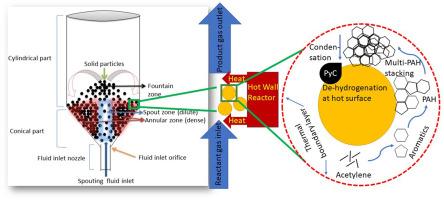Multi-scale growth mechanism of pyrolytic carbon from acetylene by chemical vapor deposition in spouted bed environment
IF 4.3
2区 材料科学
Q2 ENGINEERING, CHEMICAL
引用次数: 0
Abstract
The growth process of pyrolytic carbon (PyC) over zirconia microspheres was investigated at length scales starting from 10−10 m to 10−6 m using Transmission and Scanning Electron Microscopy, Raman spectroscopy, Small Angle X-ray and Neutron Scattering. The extent of multiphase reactions which evolved through the formation of nano-crystalline carbon have been studied here right from the formation of the disc shaped crystallites of about 3–4 nm in diameter to fused lumps comprising of spherical stacks ca. of 100 nm diameter. The observations have been correlated with the deposition conditions, which affect reaction mechanisms. Based on these observations, a plausible mechanism for the deposition of PyC coatings at different length scales has been proposed with a novel concept of role of thermal boundary layer adjacent to the deposition surface. Pore volume measurement further validated our proposed growth mechanism at a length scale of 10−6 m. Analysis of residence time of the acetylene precursor within the solid bed of zirconia microspheres has shown to have great potential in exploring growth mechanism of multiphase reactions.

喷淋床环境下化学气相沉积乙炔热解碳的多尺度生长机理
利用透射电镜、扫描电镜、拉曼光谱、小角x射线和中子散射等研究了氧化锆微球上热解碳(PyC)在10 ~ 10 ~ 6 m范围内的生长过程。本文研究了纳米晶碳形成过程中多相反应的程度,从形成直径约3-4 nm的圆盘状晶体到由直径约100 nm的球形堆组成的熔合块。这些观测结果与沉积条件有关,沉积条件影响反应机理。基于这些观察结果,提出了一种合理的PyC涂层在不同长度尺度上的沉积机制,并提出了沉积表面附近热边界层作用的新概念。孔隙体积测量进一步验证了我们在10 - 6 m长度范围内提出的生长机制。分析乙炔前驱体在氧化锆微球固体床内的停留时间,在探索多相反应的生长机理方面具有很大的潜力。
本文章由计算机程序翻译,如有差异,请以英文原文为准。
求助全文
约1分钟内获得全文
求助全文
来源期刊

Particuology
工程技术-材料科学:综合
CiteScore
6.70
自引率
2.90%
发文量
1730
审稿时长
32 days
期刊介绍:
The word ‘particuology’ was coined to parallel the discipline for the science and technology of particles.
Particuology is an interdisciplinary journal that publishes frontier research articles and critical reviews on the discovery, formulation and engineering of particulate materials, processes and systems. It especially welcomes contributions utilising advanced theoretical, modelling and measurement methods to enable the discovery and creation of new particulate materials, and the manufacturing of functional particulate-based products, such as sensors.
Papers are handled by Thematic Editors who oversee contributions from specific subject fields. These fields are classified into: Particle Synthesis and Modification; Particle Characterization and Measurement; Granular Systems and Bulk Solids Technology; Fluidization and Particle-Fluid Systems; Aerosols; and Applications of Particle Technology.
Key topics concerning the creation and processing of particulates include:
-Modelling and simulation of particle formation, collective behaviour of particles and systems for particle production over a broad spectrum of length scales
-Mining of experimental data for particle synthesis and surface properties to facilitate the creation of new materials and processes
-Particle design and preparation including controlled response and sensing functionalities in formation, delivery systems and biological systems, etc.
-Experimental and computational methods for visualization and analysis of particulate system.
These topics are broadly relevant to the production of materials, pharmaceuticals and food, and to the conversion of energy resources to fuels and protection of the environment.
 求助内容:
求助内容: 应助结果提醒方式:
应助结果提醒方式:


